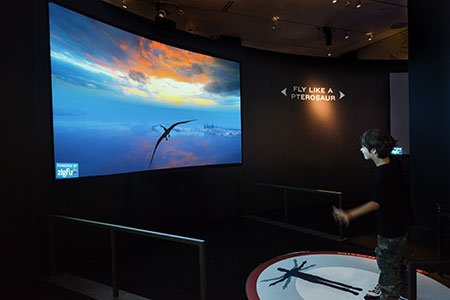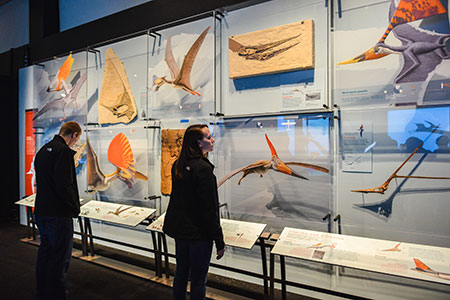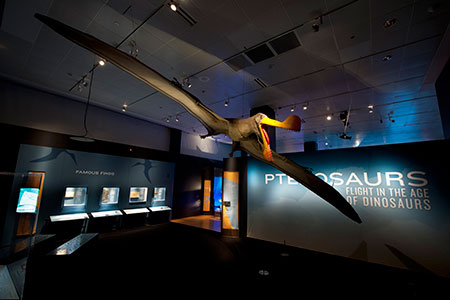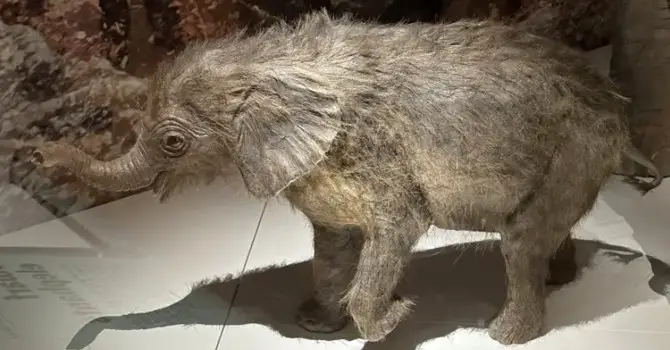Kids and adults alike will fall in love with the new exhibition Pterosaurs: Flight in the Age of Dinosaurs at the American Museum of Natural History. The largest exhibition of its kind ever mounted in the United States explores the features of more than 150 species of brilliantly colored flying reptiles, highlighting the latest research by Museum scientists and leading paleontologists around the world.
Photo: ©AMNH/R.Mickens
Pterosaurs first appeared about 220 million years ago and evolved into a diverse group: some with long, slender jaws with needle-sharp teeth, some with extravagant crests, and some with extraordinarily long wings, making these the largest flying animals ever to have existed. They have a large fourth finger, with a membrane wing that stretches in flight. Sometimes, they walked on all fours and dominated shoreline areas. Their sizes vary: some sparrow-size with a wingspan of only 10 inches; some colossal, with a wingspan of more than 33 feet. The exhibit’s entrance alone will have visitors in awe, as they look up at a full-size model of a Tropeognathus mesembrinus with a wingspan of more than 25 feet! A full-size model of the 33-foot-wingspan Quetzalcoatlus northropi will be on view as well. Make no mistake-they are not dinosaurs, not birds, and they are not bats. They became extinct 66 million years ago.
The exhibit is a combination of rare pterosaur fossils found in Germany, the United States, and Brazil, as well as casts, life-size models, videos, and interactive exhibits that immerse visitors in the mechanics of pterosaur flight. The exhibition is overseen by Curator Mark A. Norell, chair of the Division of Paleontology, who conducts pterosaur research in Romania, China, and Mongolia, with co-curator Alexander Kellner, a Museum research associate and paleontologist at the Museu Nacional in Rio De Janeiro, Brazil.

©AMNH/D. Finnin
Pterosaurs did move on land (tracks have been found in Korea and Portugal), but flight is a special area of focus, drawing comparisons between pterosaurs and contemporary winged vertebrates, birds and bats. One of the exciting, interactive aspects of this exhibit includes a section where visitors have the chance to “pilot” a flying pterosaur over a prehistoric landscape complete with forest, sea, and volcano in a whole-body interactive exhibit that uses motion-sensing technology.

©AMNH/D. Finnin
There’s been a bit of a renaissance with Pterosaur findings. “Pterosaurs remains were initially found in the 1830s-1840s, in Bavaria, South Coast of England and the U.S.,” says Norell. “But then in 1977, there was a whole new chapter, with remains found in Brazil. More have been found in China.” The exhibit will also include a fossil of a yet unknown species of a giant pterosaur unearthed in Germany in 2012, by scientists working in association with AMNH. “This is an excellent time to do an exhibit on pterosaurs, largely because there have been more significant pterosaur fossil discoveries than ever before and more technology available to help us to study them.”
In addition to the iPad stations where visitors can sit and learn the traits of varied pterosaurs, AMNH now has available its own Pterosaur app, where you can test your own knowledge. Visit amnh.org/apps for more information. Pterosaurs: Flight in the Age of Dinosaurs is at AMNH through Jan. 4, 2015.







